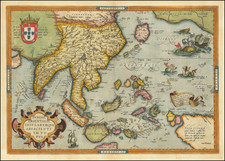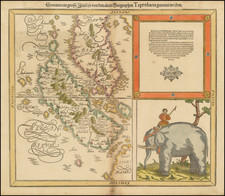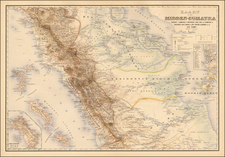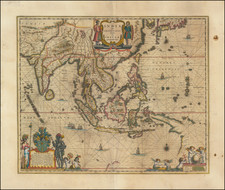A New Chart of The Java Sea, within the Isles of Sunda with its Straits and the Adjacent Seas, produced by Robert Laurie & James Whittle in 1799, illustrates the region extending from the southern part of Borneo, Sumatra and Pulau Bangka to Java, Bali, and the islands to the east. This detailed sea chart exemplifies the high navigational precision characteristic of Laurie & Whittle's charts, and represents an essential navigational tool for mariners navigating these waters at the end of the 18th century.
The chart exhibits a variety of pertinent maritime information, including sailing directions, soundings, and valuable notes for sailors. The annotated paths of the British Portobello Sloop in 1755, the French ship Mascarin in April 1772, Warren Hastings in 1781 and 1787, and the Pitt in 1759, offer an engaging overview of the shipping activity in the region during this period. Furthermore, the inclusion of multiple coastal profile views enhances the chart's practical utility by providing sailors with visual references for approaching different islands.
A prominent inset presents a detailed view of the eastern side of the Isle of Lubeck, adding an additional layer of navigational data to this complex maritime landscape. On land, the chart depicts various indigenous regions within Java, including the Kingdom of Jakarta and the Kingdom of Bantam, providing further context to the region's socio-political fabric during this period.
Also noteworthy is the large extract from New York's Commercial Advertiser of June 15, 1799, documenting the unfortunate loss of the American Ship Ontario. This account, drawn from the ship's log-book, underscores the dangers inherent in maritime voyages, and further affirms the chart's role as a critical aid for navigating these treacherous waters. In its comprehensive representation of both the maritime landscape and historical events, the A New Chart of The Java Sea stands as a testament to the vibrant seafaring history of the region.
James Whittle (1757-1818) was a British engraver and map printer. Whittle was employed by Robert Sayer (ca. 1725-1794). Together with Robert Laurie (1755?-1836), he took on Sayer’s business when the older man died in 1794. The two traded together as Laurie & Whittle until 1812, when Laurie retired. They had specialized in sea charts and maritime atlases. Whittle then partnered with Laurie’s son, Richard Holmes Laurie, until he died in 1818.
Robert Laurie (1755?-1836) was a British engraver and printseller who specialized in engraving portraits and in publishing maritime charts. His family originated in Dumfriesshire. As a young man he came to London and was apprenticed to Robert Sayer (ca. 1724-1794) in 1770. He received several awards in the 1770s for his mezzotint engraving and printing. He worked for Sayer as apprentice, assistant, and later partner.
In 1794, when Sayer died, Laurie took on his business alongside James Whittle, his fellow Sayer employee. Laurie managed the business and ceased almost all engraving. Instead, he oversaw the prodigious output of printed materials, especially sea charts and maritime atlases. He retired in 1812.
Laurie’s son, Richard Holmes Laurie, took over his part of the business and continued in business as Whittle & Laurie, rather than the previous Laurie & Whittle. Whittle died in 1818, leaving Richard as the sold proprietor of the business. Robert died in 1836 in Hertfordshire.













![[ Philippine Islands & Spice Islands ] Isles Philippines et Moluques . . .](https://storage.googleapis.com/raremaps/img/small/99646.jpg)
![(Spice Islands) [Banda, Goonog Appee or Burning Mountain, and Banda Neira]](https://storage.googleapis.com/raremaps/img/small/94740.jpg)